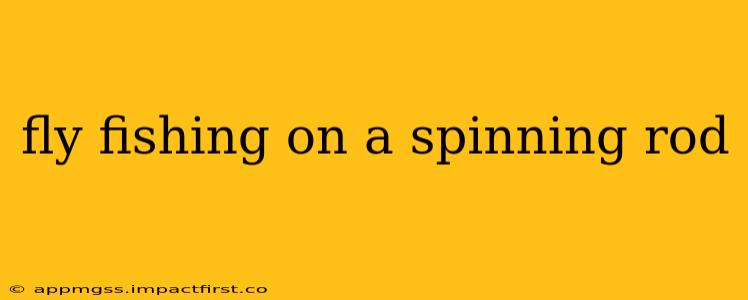Fly fishing, with its graceful casts and delicate presentations, is often associated with specialized fly rods. However, the notion that you must use a fly rod for fly fishing is a misconception. While traditional fly rods offer unmatched sensitivity and casting capabilities for many situations, resourceful anglers have successfully adapted fly fishing techniques to spinning rods for years. This opens up new possibilities, especially for anglers on a budget or those looking to explore different fishing styles. This article will delve into the surprising effectiveness of using a spinning rod for fly fishing, exploring its advantages, limitations, and practical applications.
Why Use a Spinning Rod for Fly Fishing?
This technique isn't about replacing the fly rod entirely; it's about expanding your angling options. Here are some compelling reasons to consider using a spinning rod for fly fishing:
- Accessibility and Cost: Spinning rods are significantly more affordable and readily available than fly rods and reels. This makes fly fishing accessible to a wider range of anglers, particularly beginners.
- Versatility: A single spinning rod can handle various fishing situations, unlike specialized fly rods often designed for specific fly types and conditions.
- Casting Power: Spinning rods, especially heavier models, can generate more power for longer casts, particularly advantageous in windy conditions or when targeting fish at a distance.
- Familiarity: For anglers already proficient with spinning gear, the transition is smoother and requires less learning curve compared to mastering fly casting techniques.
What Kind of Spinning Rod is Best for Fly Fishing?
Choosing the right spinning rod is crucial for success. You'll need a rod that's:
- Medium-Light to Medium Action: This action offers a balance between sensitivity and casting power, ideal for presenting smaller flies effectively.
- Length: A 6- to 7-foot rod is a good starting point, offering maneuverability and casting accuracy. Longer rods might be beneficial for distance casting in open waters.
- Suitable Line Weight: Opt for a rod rated for 6- to 10-pound test line, providing enough strength to handle various fly sizes and fish species.
What Flies Work Best with a Spinning Rod?
While you can adapt various flies, certain patterns lend themselves better to this technique. Generally, flies with:
- Heavier Bodies: Streamers, weighted nymphs, and larger dry flies are easier to cast and control with a spinning rod.
- Durable Construction: Choose flies constructed to withstand the slightly more forceful retrieves typical of spinning rod techniques.
Can You Use a Fly Reel on a Spinning Rod?
No, you cannot directly attach a fly reel to a spinning rod. The reel seats are incompatible. You'll be using a standard spinning reel with monofilament or braided line.
What Line Should I Use Fly Fishing with a Spinning Rod?
Monofilament line or braided line are both suitable options. Monofilament offers good visibility and knot strength, while braided line provides superior sensitivity and casting distance. Choose a line weight appropriate for your rod and the size of flies you'll be using. A 6-8lb test monofilament or a 4-6lb test braided line is often a good starting point.
What are the Limitations of Using a Spinning Rod for Fly Fishing?
While effective in certain scenarios, spinning rods for fly fishing do have limitations:
- Sensitivity: Spinning rods lack the exquisite sensitivity of fly rods, making it slightly more challenging to detect subtle strikes.
- Casting Precision: Achieving the delicate, precise casts essential for some fly fishing situations can be more difficult with a spinning rod.
- Presentation: The heavier line and different casting style can affect the natural drift and presentation of the fly, potentially spooking wary fish.
Is it Effective to Fly Fish with a Spinning Rod?
The effectiveness of using a spinning rod for fly fishing depends heavily on the target species, fishing conditions, and angler skill. It's a valuable alternative in certain situations, but it's not a replacement for a fly rod for all applications. For beginners or anglers on a budget, it's a great way to explore the world of fly fishing. For experienced anglers, it can be a useful tool to add to their arsenal. The key is understanding its limitations and adapting your techniques accordingly.
